Monday, May 27, 2013
Ammonia and Nitrate Results
As you can see by the graph, the ammonia levels throughout this entire project have stayed relatively the same, staying at 0.25 most of the time. The nitrate level however fluctuated a bit before leveling out. However, this was normal because of the death of one of our fish.

Thursday, May 23, 2013
Aquarium Changes
There has been many changes to my aquarium during this nine weeks. First of all, originally, I had perfect a nitrate level but had high ammonia. Once we added fish and bacteria to the aquarium, our ammonia levels dropped significantly. However, once we had a buildup of feces and one of our fish died, our nitrate level increased dramatically. To reduce this, we added plenty of duckweed because plants absorb nitrate. After some time, our water started to turn brownish but our water quality tests always turned out good so I saw no reason to change it. There was some algae growth on Squidward's house and on the fake plants, but other than that, there was no plant growth.

Thing Learned From the Aquarium Project
The aquarium project that was assigned to me at the beginning of the last nine weeks this semester has allowed me to gain more knowledge about caring for fish and maintaining water quality than I ever thought I'd know. To begin with, the assignment showed me how harmful ammonia can be towards my aquarium. The ammonia doesn't kill fish immediately but it does add extra stress on your fish which can lead to eventual death. Also, I learned that chlorine is the number one cause of death in aquariums. It didn't even occur to me that the water I was putting in the tank contained chlorine. Thankfully, my teachers stressed the importance of adding dechlorinator to make sure you don't kill your fish. Similarly, I learned that high nitrate levels can kill your fish. Before this project, I didn't know much about the nitrogen cycle, including how ammonia is broken down into nitrite by nitrosomonas and then broken down into nitrate by nitrobacter. Also, over time, I learned that less really is more when feeding my fish. The excess of food led to high nitrate levels, so after a bad nitrate test happened, my group and I decided to put less food in the aquarium. Lastly, you have to be careful which fish you choose to place in your aquarium because certain breeds of fish don't do well with each other and can become quite aggressive. If I had to change this project, I would have the students take care of their fish the entire semester instead of only nine weeks, which would allow students to add more fish and become more familiar with different breeds of fish.

Wednesday, May 22, 2013
Aquarium Update
So time to update you on my aquarium again. First of all, Fish is now the fish to eat first everyday. Cow always eats the most food as his name would suggest. Meep is still being antisocial, avoiding everyone. Also, apparently we have a snail. I saw it on the glass and was confused but it was kinda cute so I left it there. He doesn't have a name, but he does move which wall he's chilling on everyday. It's entertaining to find where he is everyday. Also, my water quality tests haven't changed at all. Ammonia is .25, nitrate is 10, and temperature is 70 degrees Fahrenheit. As a result of these good results, we haven't made any changes to the aquarium.

Invasive Plants
A plant is considered invasive if it does not grow naturally in an area. There a numerous invasive plants in Texas. Some include:

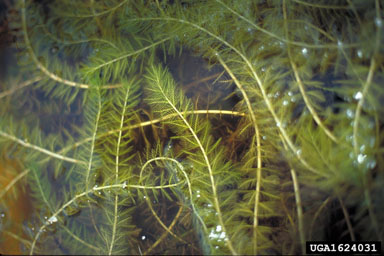

- Alligator Weed: Emergent plant that is green with white flowers, originating from South America that is an aggressive, mat-forming perennial. It spreads from seed or plant fragments. It causes displacement of native vegetation and can impede navigation.

- Eurasian Watermilfoil: A submergent green plants with red stems when actively growing. It's from Eurasia and was introduced to America in the 1950s. It reproduces by seed fragments, stolens, and is spread by boats, trailers, and birds. It shades out native vegetation, displaces native vegetation, and can impede navigation.

- Giant Salvinia: A free floating aquatic fern than has hair structures that look like egg beaters. It reproduces through buds and is also known as the plant from hell. It's originated from South America and decreases oxygen levels in water, kills lakes, impedes navigation, displaces native vegetation, and once you get it, it's nearly impossible to eradicate it.

These plants aren't a problems in their natural habitat because there, there are insects and disease that keeps the population under control.
Water Quality in My Ecosystem
I've learned a lot since the begging of this project as a result of having to take care of fish in an aquarium. I've learned that a high ammonia reading is bad because it can kill the fish. Also, high nitrate can kill fish. However, the most sure way I've learned to kill fish is not dechlorinating the water. The problems I've had in my aquarium was high ammonia so I added bacteria to break it down. The success was that only one of my fish died, and even the one that died didn't die because of me, he was just sick by himself.

Aquarium Update
When I approached the aquarium, Fish and Cow swam to the surface of the water as if they knew I was the food source. Fish is now the normal one to eat first out of all the fish. Cow eats second while Meep seems to be always hesitant to eat, as if he's intimidated by the other fish. Then, Fish started to chase Meep around the tank for a few seconds. Cow seems to be gaining weight, living up to his name. Our water in the aquarium now has a brown haze but since we're almost done with the aquarium project, I see no need to do a water change. Our ammonia is .25, nitrate is 10, and the temperature is a constant 70 degrees Fahrenheit. These result show that even though our water is brownish, the water quality is still good. No changes have been made because of these good results.

Self-sustaining
Self-sustaining means to be able to exist without outside help. In an ecosystem, self-sustaining means that the natural cycles that occur are able function properly without help from others. My ecosystem is not entirely self-sustaining. Without me, the fish would starve to death because there would be no source of food anymore. Also, the water would eventually evaporate, killing the fish. If there was no bubbler in the aquarium, the fish would die from lack of oxygen. If we didn't do water changes, ammonia tests, and nitrate tests, the fish would die from the pollution they created themselves. As a result of these numerous reasons, the aquarium is far from self-sustaining.

Tuesday, May 21, 2013
My Ecosytem's Water Quality
I believe that my ecosystem's water quality is pretty decent. Compared to a pond, I think that my ecosystem's water has less diversity in plants and insects than a pond. Ponds are shallower than my ecosystem's water, allowing plants to grow across the entire pond unlike an aquarium would. Also, because of the increased diversity, the diversity of insects would be greater.

On the other hand, my ecosystem's water would have a better water quality than a river because it's smaller and I can adjust it easier than changing an entire river's water quality.


On the other hand, my ecosystem's water would have a better water quality than a river because it's smaller and I can adjust it easier than changing an entire river's water quality.

The Nitrogen Cycle
The nitrogen cycle is imperative in an aquatic ecosystem. It starts out when food is put into the water and the fish urinate. One of the main components in urine is in fact ammonia. The ammonia is then broken down into nitrite by the bacteria nitrosomonas. The nitrite is then broken down by the bacteria nitrobacter into nitrate. Once in this form, plants take up the nitrate, though this is only temporary because once the plant dies, the nitrate is then released back into the water. Without the nitrogen cycle, ecosystems couldn't function properly because the build up of ammonia will kill the fish and other organisms.


Monday, May 13, 2013
Aquarium Update
Since the start of this project, our water has been slowly decreasing. In total, it decreased about 3 inches so we decided it was about time that we add more water, making sure we dechlorinated before adding it. At first after Exstacy's death, Meep had been more social, venturing further out into the middle of the tank. However, Meep has started to become more of a recluse again, staying in his corner of the tank and avoiding the other fish. Cow and Fish have not experienced any change in their behavior at all. Our water quality test was 20 for nitrate, .25 for ammonia, 21 degree Celsius/70 degree Fahrenheit, and no water changes. The dissolved oxygen was 10 mg/L. The results of all these tests mean that our water quality is still good. As a result of this, we have made no changes.

Dichotomous Key
A Dichotomous key is used to identify something through the use of questions. To use one, read the first question. The answer describing the object you're looking at will have a number next to it. Go to that question and repeat the steps. Eventually, one of the answers that you get will have a name next to it. This is the correct identification of the object you're looking at.

To make my own, I stared out with color and moved into more specifics from there. The problems I encountered was figuring out how to phrase the descriptions into questions and how to make the questions in a way in which i wouldn't give too much information away. After thinking about how I could phrase it, I came up with the best way to construct the questions, solving my dilemma.
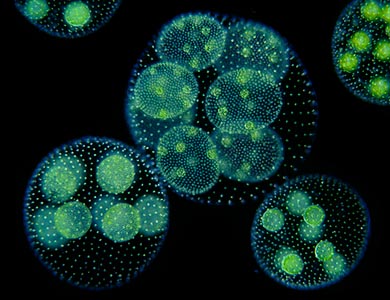

To make my own, I stared out with color and moved into more specifics from there. The problems I encountered was figuring out how to phrase the descriptions into questions and how to make the questions in a way in which i wouldn't give too much information away. After thinking about how I could phrase it, I came up with the best way to construct the questions, solving my dilemma.

Thursday, May 9, 2013
Pollution Index Chart
A pollution index chart is used to determine the quality of water. To use one, count the number of a certain algae then divide by 5. If the number of algae in the sample is below before dividing, then just ignore it. Continuing, always round down when dividing. Even if the number is 4.9, it would be 4. Next, take that number and multiply it by the number in the column of the corresponding algae. Once finished, add all the algae numbers together. If the number is 20 or greater, the pollution is high, if the number is between 15-19, the level is probable, and if the number is 14 or less, the pollution is low. The benefits of using a pollution index chart include knowing what algae is in the water and what condition the water is in. However, the drawback is that it's only a pollution index for a small sample of the entire body of water so the results could be deceiving. If the population of certain algae is high but the diversity is low, the water is polluted, possibly as a result of organic pollutants. When the diversity of algae is high but the population is low, the water is cleaner and healthier.


Tuesday, May 7, 2013
Assesing Water Quality
There are a few steps one should follow in order to assess a body of water. The first is that you should evaluate by observation. See if there is an algae bloom that could indicate pollution, or a particular smell that could tell you what particular algae is growing in the water. Next, capture and identify algae. Certain algae will tell you what kind of condition the water is in. If it's an algae such as Anabaena, the water would be in poor quality. Next, test the pH, ammonia levels, temperature, dissolved oxygen levels, nitrate levels, and nitrite levels. Finally, run a panel of chemical tests. It's important to do the steps in this order because it can save you time as well as money. Organisms such as algae or the lack of algae could help you determine how bad/good the water just by observation instead of having to run chemical test which would be a waste of time and money.


Dissolved Oxygen in an Ecosystem
Two sources of dissolved oxygen is contact with the atmosphere and plants in the water. Throughout the day, the levels of oxygen and carbon dioxide fluctuates. When the sun is up, the levels of oxygen increases as plants undergo photosynthesis while the levels of carbon dioxide decrease as a result of the plants absorbing it. During the night however, levels of CO2 increases while O2 decreases. This is because even though production of oxygen by plants ceased for the day, other organisms are still undergoing cellular respiration, using the remaining oxygen while producing CO2.


Dissolved Oxygen
Dissolved oxygen is the amount of oxygen in the water. To do a dissolved oxygen test, first take the "special cylinder", as Ms Wind put it, and fill it with 25 mL of water from your tank. Next, take one of the glass tubes that's filled with a straw color yellow. Next, place it in the cylinder, breaking the tip off. Let it sit in the water for a few seconds before removing it. Then, place your finger over the opening, covering it and gently swish is around. then, let it sit for about two minutes. Lastly, compare your results with the chart. If the level is below 3 mg/L, there isn't enough dissolved oxygen and your fish will die. Anything over 5 mg/L can support life and is a good dissolved oxygen test result. My results were 10 mg/L which is good. In a small pond, the dissolved oxygen is probably lower than in a large river because a pond is usually warmer which holds less dissolved oxygen and fast moving water is more air rated, allowing for more dissolved oxygen.

The darker the blue, the more dissolved oxygen there is.

The darker the blue, the more dissolved oxygen there is.
Aquacheck
Aquachecks are important to know the quality of your water, whether it be in an aquarium or something else. The five components of an aquacheck are free chlorine, total chlorine, total hardness, total alkalinity, and pH. Free chlorine refers to the free ions in the water while total chlorine is the combination of free chlorine and combined chlorine which is the combination of ammonia to form chloramine. Total hardness refers to the amount of dissolved minerals in the water. Total alkalinity is the measure of the buffering capacity of water, or in laymen terms, the resistance to change in pH. pH is how acidic or basic water is, ranging from 0-14, 0 being the most acidic while 14 is the most basic and 7 is neutral.
The results of my aquacheck was .5 for free chlorine, 0 for total chlorine, 250 for total hardness, 180 for alkalinity and 7.8 for pH. Overall the results were good except for the free chlorine because chlorine is what kills fish. The hardness is good for the fish I have selected for my aquarium and the alkalinity is decent because a higher number means a higher resistance to change in pH. The pH was neutral/slightly basic which is good. A pH of 4 affects fish reproduction and a pH of 3 kills adult fish. So all in all, the aquacheck showed that my water was good for my fish to live in.
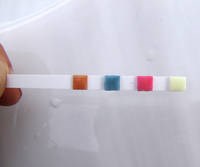
The results of my aquacheck was .5 for free chlorine, 0 for total chlorine, 250 for total hardness, 180 for alkalinity and 7.8 for pH. Overall the results were good except for the free chlorine because chlorine is what kills fish. The hardness is good for the fish I have selected for my aquarium and the alkalinity is decent because a higher number means a higher resistance to change in pH. The pH was neutral/slightly basic which is good. A pH of 4 affects fish reproduction and a pH of 3 kills adult fish. So all in all, the aquacheck showed that my water was good for my fish to live in.

My Fish
Well as of now, I only have three fish; a minnow, a Dalmatian Lyretail Molly, and a Red Mickey Mouse Platy. Each fish has different requirements and behavior.
Some minnow behaviors and requirements include:
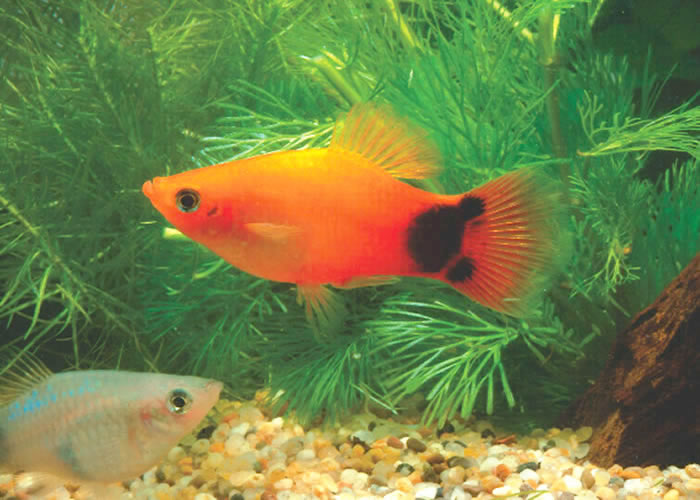
Some minnow behaviors and requirements include:
- Most minnows do well in single-species groups in 20-gallon aquariums with canister or trickling filtration
- water changes
- They do well on a diet of flakes
- Most cannot tolerate heat, and some require a chiller.
- Dart around
- Don't stay in the same place for too long
- Not affected as much as other fish to certain levels or ammonia or nitrate
- Male minnows make a knocking sound when threatened by other males
- Have a bubbler to keep oxygen in the water
- Only need to be fed once a week
- Minimum tank size needed is 25 gallons
- Water pH: 7 to 8.5
- Water Hardness: Medium hard to hard
- Temperature needed is 78-82°F
- Does best with two or more Mollies. Will successfully live with Angels, Barbs. Danios, Gouramis, Platies, Rainbows, Tetras and other community fish
- Ir will eat algae and aquarium plants
- Favors living in the upper half of the aquarium
- It is a non-aggressive fish which gets along with others very well
- This fish prefers an aquarium with a sandy or gravel bottom, good filtration, and lots of real or plastic plants and wood features along the tank walls.
- The Dalmatian Lyretail Molly can successfully live in a wide variety of aquarium setups
- Water temperature: 72-82° F
- Tank Setup: 10+ gallons, moderately planted
- Active, peaceful, schooling fish that mix well with other community fish
- Live bearing species, meaning they give birth to free-swimming offspring
- Hardness: 10-25 dGH
- They will graze on vegetation
- Tank Level: Mid dweller
- Suitable for even small aquariums
- Alkaline water of moderate hardness is ideal
- A varied diet including plenty of vegetable matter will insure good health

Sunday, May 5, 2013
The Dallas World Aquarium
The field trip was really fun, however, I almost didn't make it as a result of my 1st period substitute teacher not letting me leave the class, causing me to miss the bus. My stepmother drove me there, and from then on, it was a blast. I thoroughly enjoyed looking at all the animals and the overall atmosphere of the aquarium. However, I felt as though we were rushed so I missed a few exhibits. I would've liked to stay longer than we did. The most interesting thing I saw was the saw fish. It just looked so different from everything else, plus it was really awesome being in the shark tunnel and have it swim overhead.


Five things I learned from this field trip include:




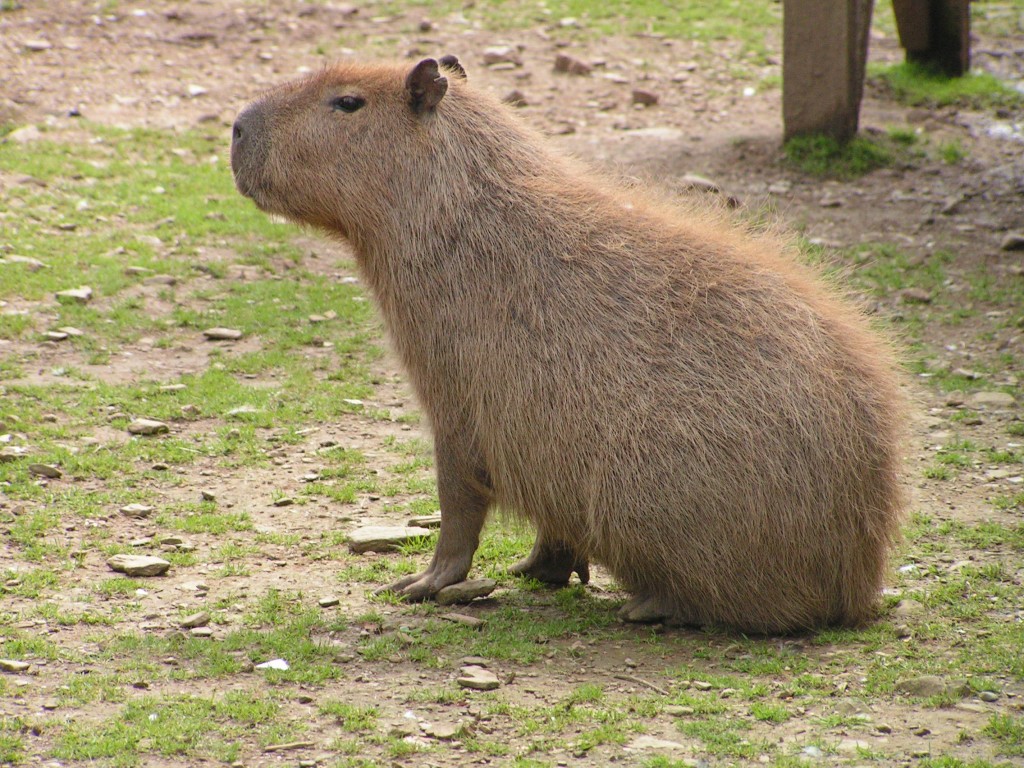
Five things I learned from this field trip include:
- The Japanese Spider Crab is dimorphic, meaning that the male and female look different

- The Matschie's Tree Kangaroo is an endangered animal
- Spotted Eagle Rays tend to stay in groups
- Sloths move so slow that algae grows on their fur, providing camouflage for it
- Capybaras are the world's largest rodents

Aquarium Update
So I was absent for the first two days of the week and came into class Wednesday to find out that Exstacy had died. For the past week, his left eye had been inflamed, almost three times the normal size, and had white parasite-looking things attached to his body. We had tried fish medicine, however, I guess that didn't work because my partners found his upside down in Squidward's house.Following Exstacy's death, Meep became slightly more active, swimming further into the middle of the tank. Also, the water now is a hazy brown. Our test results were .25 ppm for ammonia, 160 ppm for nitrate,70 degrees Fahrenheit, and 21 degrees Celsius. The nitrate level was this high as a result of Exstacy's death. This is normal and should decrease is a few days. Meanwhile, Fish and Cow have not changed in behavior at all. Cow still eats like no other and Fish darts around a lot.

Monday, April 29, 2013
Algae
This week in aquatic science, I've learned more about algae than I thought I ever would. Some information included multiple different types of algae. First, I learned about Volvox. This algae forms in spheres of 500 or more cells which from a colony. It has two flagella and reproduces by daughter cells. This particular algae has a fishy odor and causes blooms during the summer, resulting in damage to gills of young fish.
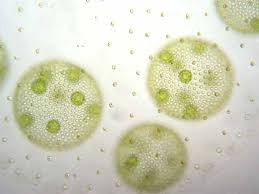
Straurastrum is an algae that has a grassy odor. This algae has spike projectiles that increases its surface area, allowing it to float more easily.

Anabaena is and algae that has a pig pen odor. This algae is toxic, damages animals, and is associated with skin rashes. Anabaena is an algae that signals that the water quality is poor.
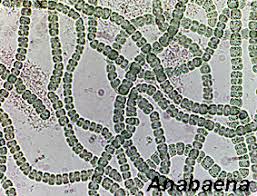
Straurastrum is an algae that has a grassy odor. This algae has spike projectiles that increases its surface area, allowing it to float more easily.

Anabaena is and algae that has a pig pen odor. This algae is toxic, damages animals, and is associated with skin rashes. Anabaena is an algae that signals that the water quality is poor.
Microscopes
Microscopes are used to magnify objects. On a standard microscope, there are three different magnifications; scanning objective, low power objective, and high power objective.The ocular lens, or eyepiece, magnifies an object 10 times its actual size. Keeping this in mind, the scanning objective is 4 times the original object size, however, while looking through the ocular lens, the total magnification is 40 times the actual size of the object. The low power objective is 10 times the actual size, and when looking through the ocular lens, it's 100 times the size. The high power objective is 40 times the size of the object making the size of the object 400 times the actual size when looking through the ocular lens. Each objective is marked by a color ring around it. The scanning objective ring is red while the low power objective is yellow and the high power objective is blue.
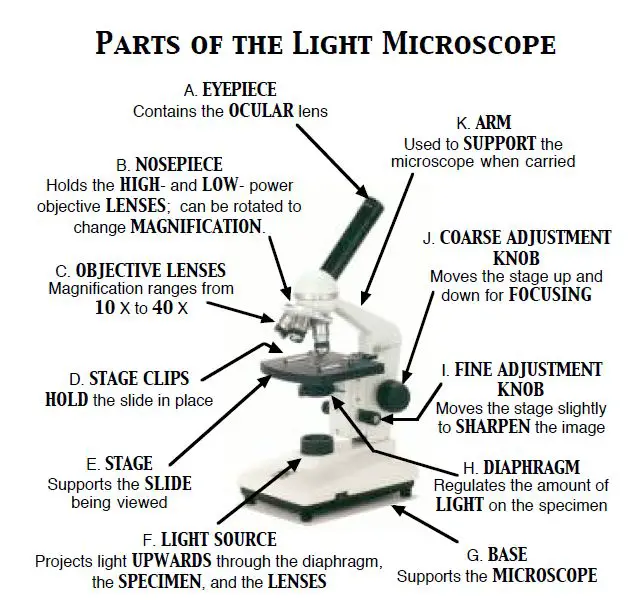
To focus of an object, start on the scanning objective first, focusing using the coarse adjustment knob and the fine adjustment knob as needed. Then, switch to the low power objective using the coarse adjustment and fine adjustment knob as needed. Finally, make sure the coarse adjustment knob is lowered before switching to the high power objective because the lens could be scratched. Only use the fine adjustment knob to focus on the object.
To make a wet mount on a slide, take your specimen and place it in the middle of your slide. Make sure that it isn't too thick or else it will make it harder to observe it. Next, place one drop of water over the specimen. Then, place the cover slip at a 45 degree angle with one edge touching the water drop and gently let go.

To stain a specimen, follow the same steps to make a wet mount. Next, place one drop of methylene blue on the edge of the cover slip. Then, place the edge of a paper towel on the opposite side of the cover slip. The paper towel will draw the water out from under the cover slip and pull the dye under the cover slip.

Doing this lab didn't really affect my microscope skills at all. I learned all this information when I was in middle school. The only thing I can think of is that you only clean the lenses with lens paper. Other than that, I knew all the information.
 I like sloths
I like sloths

To focus of an object, start on the scanning objective first, focusing using the coarse adjustment knob and the fine adjustment knob as needed. Then, switch to the low power objective using the coarse adjustment and fine adjustment knob as needed. Finally, make sure the coarse adjustment knob is lowered before switching to the high power objective because the lens could be scratched. Only use the fine adjustment knob to focus on the object.
To make a wet mount on a slide, take your specimen and place it in the middle of your slide. Make sure that it isn't too thick or else it will make it harder to observe it. Next, place one drop of water over the specimen. Then, place the cover slip at a 45 degree angle with one edge touching the water drop and gently let go.

To stain a specimen, follow the same steps to make a wet mount. Next, place one drop of methylene blue on the edge of the cover slip. Then, place the edge of a paper towel on the opposite side of the cover slip. The paper towel will draw the water out from under the cover slip and pull the dye under the cover slip.
Doing this lab didn't really affect my microscope skills at all. I learned all this information when I was in middle school. The only thing I can think of is that you only clean the lenses with lens paper. Other than that, I knew all the information.
 I like sloths
I like sloths Sunday, April 28, 2013
Amphibian Facts
Amphibians are animals that live partially in water and partially on land. There are many interesting facts about amphibians. Some include:
The wood frog lives in places as far north as Canada and Alaska, and is able to survive the freezing winters by allowing itself to freeze.

The largest amphibian in the world is the Chinese Giant Salamander, reaching up to 1.8 m in length from the nose to the tip of the tail. Other large amphibians include the Japanese giant salamander and the Goliath frog.
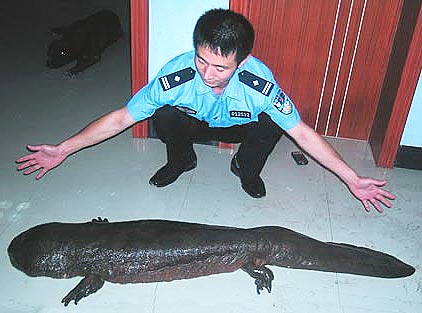
Most frogs have teeth on the upper jaw but none on the lower jaw, while toads don't have any teeth.

The plethodontids, also called "lung-less salamanders" absorb oxygen through their skin and mouth to breath since they lack lungs. Of all salamanders, the plethodontids are the most diverse group, with about 376 species. They can be found in regions such as North America, Central America, South America, southern Europe, Sardinia, and Korea.
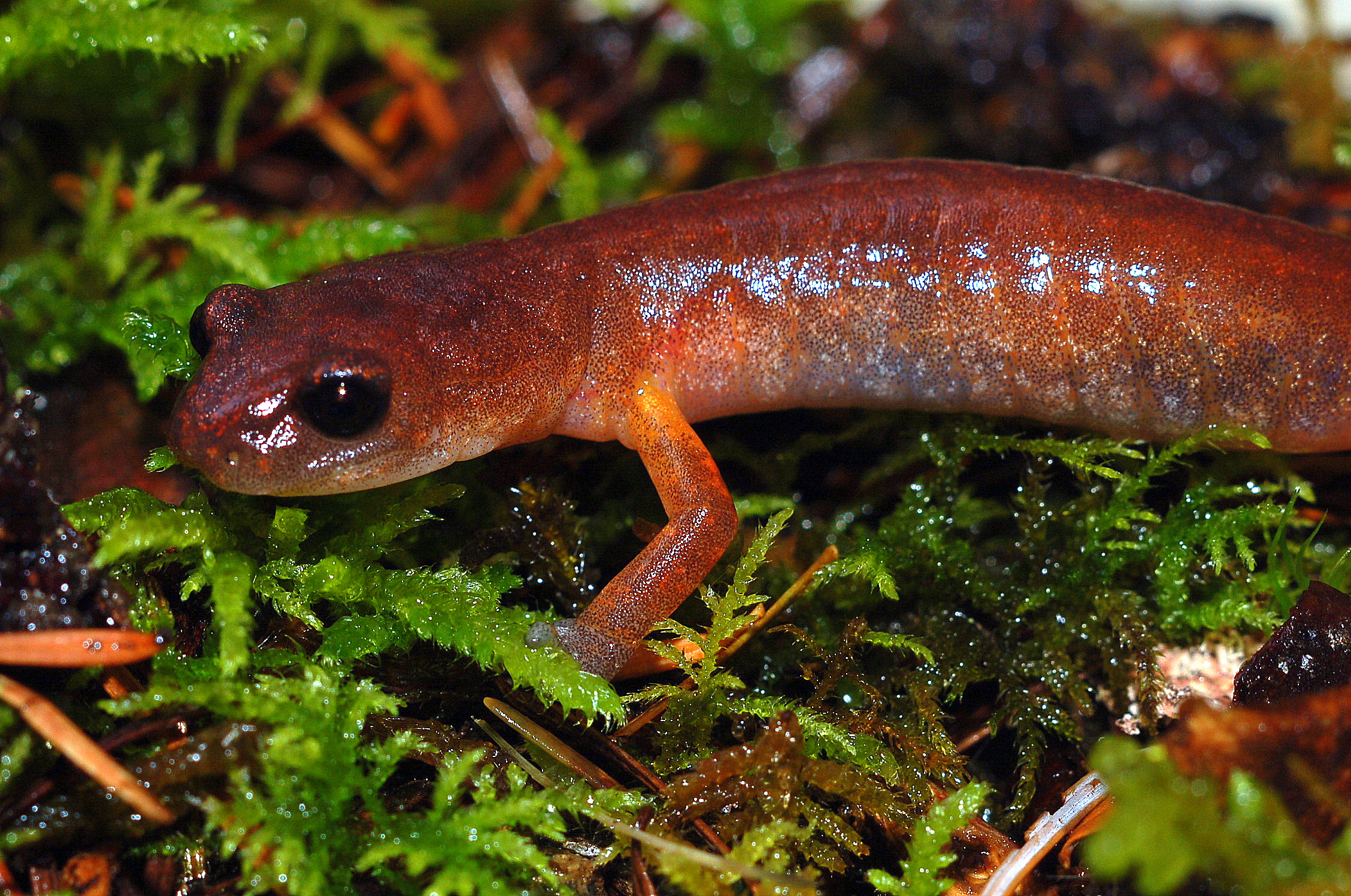
Nearly one-third of all amphibians are known to be threatened or extinct. The largest numbers of threatened species are found in Colombia, Mexico, and Ecuador. Amphibians in the Caribbean are also under serious threat where high percentages of the amphibians that live in the region are threatened or extinct.
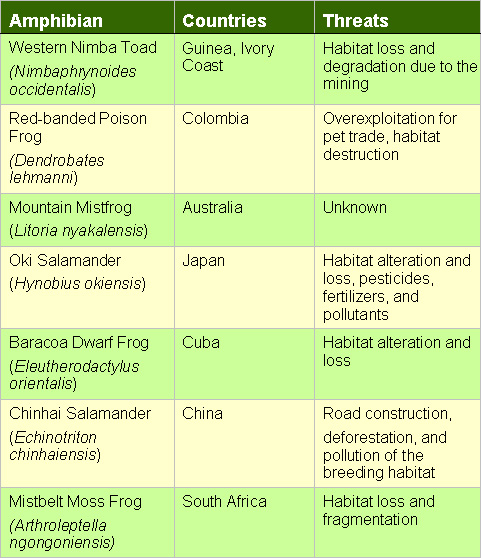
The wood frog lives in places as far north as Canada and Alaska, and is able to survive the freezing winters by allowing itself to freeze.
The largest amphibian in the world is the Chinese Giant Salamander, reaching up to 1.8 m in length from the nose to the tip of the tail. Other large amphibians include the Japanese giant salamander and the Goliath frog.

Most frogs have teeth on the upper jaw but none on the lower jaw, while toads don't have any teeth.

The plethodontids, also called "lung-less salamanders" absorb oxygen through their skin and mouth to breath since they lack lungs. Of all salamanders, the plethodontids are the most diverse group, with about 376 species. They can be found in regions such as North America, Central America, South America, southern Europe, Sardinia, and Korea.

Nearly one-third of all amphibians are known to be threatened or extinct. The largest numbers of threatened species are found in Colombia, Mexico, and Ecuador. Amphibians in the Caribbean are also under serious threat where high percentages of the amphibians that live in the region are threatened or extinct.

Tuesday, April 23, 2013
Aquarium Update
So today, unlike usual, our fish Cow was staying near the bottom, not the middle like he usually does. Also, Fish started to venture down further into the tank, closer to the other fish. Extacy was out in the open today instead of being behind Squidward's house like usual. Meep, however, has not changed his behavior at all. He still floats in his corner against the glass being anti-social. All of the fish have feces attached to them at this point . Thinking that if we scared them it would fall of, we tapped on the glass and it actually worked. There's also a buildup of feces at the bottom of our aquarium which is why, when we did our water quality test, our nitrate level increased from a 5.0 to a 10.0. To help with this, we added plants which help to lower nitrate levels. Our ammonia level went down from a 1.0 to a .25 which is really good, keeping our fish healthy. The temperature of our aquarium has stayed the same since we began.

Monday, April 22, 2013
Watersheds
A watershed is the area of land where all of the water that is under it or drains off of it goes into the same place. Being just north of Dallas, Texas, I live in the Trinity River watershed. It's important to monitor the quality of our local watershed because harmful pollutants can be washed into our freshwater from point, able to see the source of it, and nonpoint pollution, pollution that can't be traced back to single source. The benefits of watersheds include improved water quality, habitat protection, and groundwater recharge.

Saturday, April 20, 2013
Ambystoma mexicanum
The Ambystoma mexicanum, or more commonly referred to as Axolotl, is a freshwater albino Salamander that is found in freshwater, known only from central Mexico, on the southern edge of
Mexico City, in canals and wetlands in the general vicinity of
Xochimilco including outside the Xochimilco city limits, around the
Chalco wetland.

Axolotls are almost extinct in their natural habitat as a result of the introduction of predatory fish and habitat loss.

Axolotls has a flat-shaped broad head that is much wider than the body of the axolotl. They also has feathery gills which protrude from either side of the head of the axolotl, allowing it to breath under water. As with newts and salamanders, axolotls are able to regenerate limbs that become damaged or detached.

Being carnivorous, axolotl eats worms and insect larvae that develop under the surface of the water along with molluscs, crustaceans and some small species of fish.
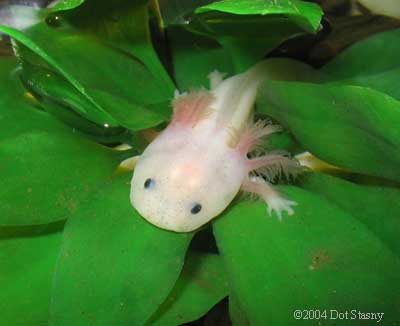
Axolotls can live for up to 25 years although the average axolotl rarely gets much older than the age of 15. Female axolotls can lay anywhere from 100 to 1,000 eggs which are coated with a sticky substance that helps them to stick to plants and rocks in the water to keep them safe. After about a month of development, tiny axolotl babies emerge into the open water.
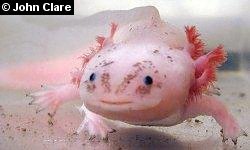
I chose this animal because, well, look at it! It looks so cute and adorable, so why not?
Chalco and Xochimilco of the Valley of Mexico near Mexico City

Axolotls are almost extinct in their natural habitat as a result of the introduction of predatory fish and habitat loss.

Axolotls has a flat-shaped broad head that is much wider than the body of the axolotl. They also has feathery gills which protrude from either side of the head of the axolotl, allowing it to breath under water. As with newts and salamanders, axolotls are able to regenerate limbs that become damaged or detached.

Being carnivorous, axolotl eats worms and insect larvae that develop under the surface of the water along with molluscs, crustaceans and some small species of fish.

Axolotls can live for up to 25 years although the average axolotl rarely gets much older than the age of 15. Female axolotls can lay anywhere from 100 to 1,000 eggs which are coated with a sticky substance that helps them to stick to plants and rocks in the water to keep them safe. After about a month of development, tiny axolotl babies emerge into the open water.

I chose this animal because, well, look at it! It looks so cute and adorable, so why not?
are almost extinct in their native habitat, largely due to the introduction of predatory fishes and habitat loss.
are almost extinct in their native habitat, largely due to the introduction of predatory fishes and habitat loss.
Chalco and Xochimilco of the Valley of Mexico near Mexico City
Chalco and Xochimilco of the Valley of Mexico near Mexico City
My Aquarium
As of April 18th, my aquarium is still going quite well. I added 3 new fish to it: a Black Molly we named Extacy,

a Dalmatian Lyretail Molly named Cow,

and a Red Mickey Mouse Platy named Meep.

Also, we named our minnow Fish.

I noticed that Fish tends to stay near the top of the water, rarely going deeper than an inch while Meep is always alone in his corner on the bottom left side of the aquarium. Cow, earning his name seems to always be hungry. By far, he eats more than any of the other fish. He also tends to chill in the middle of the tank, swimming slowly in circles. Extacy, however, seems to be constantly darting around the tank and rarely eats. When he's not darting around, he hides behind Squidward's house.
For our ammonia and nitrate test, nothing has changes in the numbers. Ammonia is still at a 1.0 and nitrate is still at a 5.0. The only thing we can really do is double the amount of bacteria we've been adding to the aquarium. We plan to do this before the next water test.
a Dalmatian Lyretail Molly named Cow,
and a Red Mickey Mouse Platy named Meep.
Also, we named our minnow Fish.
I noticed that Fish tends to stay near the top of the water, rarely going deeper than an inch while Meep is always alone in his corner on the bottom left side of the aquarium. Cow, earning his name seems to always be hungry. By far, he eats more than any of the other fish. He also tends to chill in the middle of the tank, swimming slowly in circles. Extacy, however, seems to be constantly darting around the tank and rarely eats. When he's not darting around, he hides behind Squidward's house.
For our ammonia and nitrate test, nothing has changes in the numbers. Ammonia is still at a 1.0 and nitrate is still at a 5.0. The only thing we can really do is double the amount of bacteria we've been adding to the aquarium. We plan to do this before the next water test.
Subscribe to:
Posts (Atom)